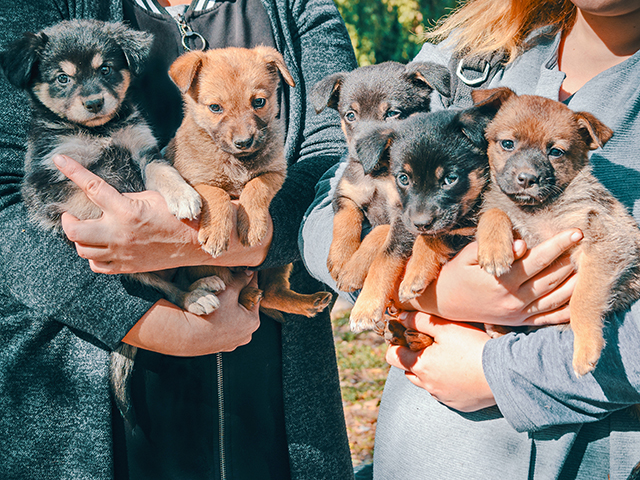Ask the Vet
Puppies, Puppies Everywhere
READER: We had a stray dog that had puppies in our barn. The puppies are all assorted colors and sizes, and look very different. I have heard that there can be more than one father to a litter. Is this true?
Dr. McMillan: Yes, there can be multiple sires to a litter of puppies. The same is true for litters of kittens. Unlike cows, dogs can stay in heat for several days. During this time, the female can, and often will, mate with more than one sire if they are not confined. Some recent research with dogs shows that litters from multiple sires are often larger, and the second sire often fathers more of the pups than the first sire.
READER: Our beef cow recently threw up lots of rumen contents, including water and partially digested hay. She is eating again, but I would like to know what can cause this?
Dr. McMillan: This seems like a pretty straightforward question, but there can be several issues behind this kind of behavior.
Cows must "chew their cud" for the rumen to function properly. They regurgitate rumen contents while resting and chew this, known as "cud," for several minutes before reswallowing it. This process is repeated over and over.
P[L1] D[0x0] M[300x250] OOP[F] ADUNIT[] T[]
In fact, 70% or more of your cows at rest should be chewing their cud. This process grinds up grasses, hay and grains, making them more available for the rumen microbes to digest. Additionally, during this process, cows secrete large volumes of saliva, which has a high pH and is essential in preventing rumen acidosis. If the pH of the rumen gets too low, many of the microbes will die, and the rumen will not function properly.
To keep the rumen healthy and happy, cows need a lot of high-quality long-stem fiber from grasses, hay and silage. Overfeeding supplemental feed or feeding very finely ground feed can lead to rumen acidosis even with adequate long-stem fiber. Poor-quality hay with low energy and protein content can also reduce rumen microbes and lead to acidosis. This can lead to "throwing up" rumen contents as you describe.
Another consideration, although very rare in beef cows, is when the abomasum, or true stomach, becomes displaced or shifts. This most commonly occurs to the left side and is called a left-displaced abomasum (LDA). This can also lead to regurgitation.
Cows will often eat feed or commodities too fast, and become choked. Again, very fine feed is more of an issue. This will often cause them to forcefully cough and gag in an attempt to clear the material from the esophagus. This can occasionally occur with hay, especially poor-quality hay, and is often difficult for the cow to clear. If the cow cannot clear the esophagus, this becomes an emergency situation. Here, the cow will be unable to regurgitate gas produced by the rumen, will bloat and, without treatment, die.
Lastly, any type of irritation or swelling in or around the throat or esophagus can interfere with normal regurgitation. I have seen this caused by ulcers in the mouth or esophagus, or abscesses or tumors around the esophagus.
READER: We raise calves off of dairy farms and sometimes we get a bull calf with a rupture that shows up by the naval at around 8 to 10 weeks. Why is this happening?
Dr. McMillan: These are most likely umbilical hernias. The umbilical cord carries nutrition and removes waste between the dam and the fetus. When the calf is born, that cord should wither away and the body wall seal. If that doesn't happen, there is a weakened area where organs can fall through, including intestines. This can become larger over time, and if the intestines become strangulated, the calf can die.
Another possibility based on what you describe is an infected naval (naval ill). In this case, the umbilical cord is infected and swells. This type of infection can actually lead to infection in other parts of the body, including the joints (joint ill).
If this is a hernia, hernias are soft and can usually be pushed back into the abdomen. If it is naval ill, it is usually hard and can be hot and painful. Umbilical hernias are a recognized genetic defect in cattle and have their highest documented incidence in Holsteins.
Hernias can be surgically repaired with a high rate of success. Naval ill is typically treated with antibiotics and anti-inflammatories.
**
-- Please contact your veterinarian with questions pertaining to the health of your herd. Every operation is unique, and the information in this column does not pertain to all situations. This is not intended as medical advice but is purely for informational purposes.
-- Write Dr. Ken McMillan at Ask The Vet, 2204 Lakeshore Dr., Suite 415, Birmingham, AL 35209, or email vet@progressivefarmer.com.
[PF_0521]
(c) Copyright 2021 DTN, LLC. All rights reserved.




